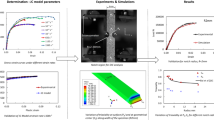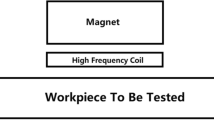Abstract
Residual stress measurement and control are highly important for the safety of structures of high-speed trains, which is critical for the structure design. The longitudinal critically refracted wave technology is the most widely used method in measuring residual stress with ultrasonic method, but its accuracy is strongly related to the test parameters, namely the flight time at the free-stress condition (t 0), stress coefficient (K), and initial stress (σ0) of the measured materials. The difference of microstructure in the weld zone, heat affected zone, and base metal (BM) results in the divergence of experimental parameters. However, the majority of researchers use the BM parameters to determine the residual stress in other zones and ignore the initial stress (σ0) in calibration samples. Therefore, the measured residual stress in different zones is often high in errors and may result in the miscalculation of the safe design of important structures. A serious problem in the ultrasonic estimation of residual stresses requires separation between the microstructure and the acoustoelastic effects. In this paper, the effects of initial stress and microstructure on stress coefficient K and flight time t 0 at free-stress conditions have been studied. The residual stress with or without different corrections was investigated. The results indicated that the residual stresses obtained with correction are more accurate for structure design.










Similar content being viewed by others
References
R. Unnikrishnan, K.S. Idury, T. Ismail, A. Bhadauria, S. Shekhawat, R.K. Khatirkar, and S.G. Sapate, Effect of Heat Input on the Microstructure, Residual Stresses and Corrosion Resistance of 304L Austenitic Stainless Steel Weldments, Mater. Charact., 2014, 93, p 10–23
L. Basatskaia and I. Ermolov, Theoretical Study of Ultrasonic Longitudinal Subsurface Waves in Solid Media, Sov. J. Nondestruct. Test., 1981, 16, p 524–530
W. Baldwin, Jr., Residual Stress, Met. Prog., 1955, 68, p 89–96
Y. **e, Y. Wu, J. Burns, and J. Zhang, Characterization of Stress Corrosion Cracks in Ni-Based Weld Alloys 52, 52M and 152 Grown in High-Temperature Water, Mater. Charact., 2016, 112, p 87–97
M. Marques, A. Ramasamy, A. Batista, J. Nobre, and A. Loureiro, Effect of Heat Treatment on Microstructure and Residual Stress Fields of a Weld Multilayer Austenitic Steel Clad, J. Mater. Process. Technol., 2015, 222, p 52–60
G. Gnirss, Vibration and Vibratory Stress Relief. Historical Development, Theory and Practical Application, Weld. World, 1988, 26, p 284–291
G. Gou, M. Zhang, H. Chen, J. Chen, P. Li, and Y. Yang, Effect of Humidity on Porosity, Microstructure, and Fatigue Strength of A7N01S-T5 Aluminum Alloy Welded Joints in High-Speed Trains, Mater. Des., 2015, 85, p 309–317
N. Rossini, M. Dassisti, K. Benyounis, and A. Olabi, Methods of Measuring Residual Stresses in Components, Mater. Des., 2012, 35, p 572–588
P.S. Prevey, X-ray Diffraction Residual Stress Techniques, ASM Int. ASM Handb., 1986, 10, p 380–392
L. Meisner, A. Lotkov, M. Ostapenko, and E.Y. Gudimova, X-ray Diffraction Study of Residual Elastic Stress and Microstructure of Near-Surface Layers in Nickel-Titanium Alloy Irradiated with Low-Energy High-Current Electron Beams, Appl. Surf. Sci., 2013, 280, p 398–404
A.B. Bouda, S. Lebaili, and A. Benchaala, Grain Size Influence on Ultrasonic Velocities and Attenuation, NDT E Int., 2003, 36, p 1–5
W.A. Olsson, Grain Size Dependence of Yield Stress in Marble, J. Geophys. Res. Atmos., 1974, 79, p 4859–4862
S.M. Kumaran, Evaluation of Precipitation Reaction in 2024 Al–Cu Alloy Through Ultrasonic Parameters, Mater. Sci. Eng. A, 2011, 528, p 4152–4158
P. Marie-Aude, E.G. Rachid, J. Moysan, G. Corneloup, and B. Chassignole, Acoustical Characterization of Austenitic Stainless Steel Welds for Experimental and Modeling NDT, J. Adv. Sci., 2005, 17, p 76–81
C.M. Sayers, Ultrasonic Velocities in Anisotropic Polycrystalline Aggregates, J. Phys. D Appl. Phys., 2000, 15, p 2157–2167
C.H. Gur and I. Cam, Comparison of Magnetic Barkhausen Noise and Ultrasonic Velocity Measurements for Microstructure Evaluation of SAE 1040 and SAE 4140 Steels, Mater. Charact., 2007, 58, p 447–454
Y.H. Nam, Y.I. Kim, and S.H. Nahm, Evaluation of Fracture Appearance Transition Temperature to Forged 3Cr–1Mo–0.25V Steel Using Ultrasonic Characteristics, Mater. Lett., 2006, 60, p 3577–3581
K. Sawada, T. Hara, M. Tabuchi, K. Kimura, and K. Kubushiro, Microstructure Characterization of Heat Affected Zone After Welding in Mod. 9Cr–1Mo Steel, Mater. Charact., 2015, 101, p 106–113
F. Khodabakhshi, M. Haghshenas, S. Sahraeinejad, J. Chen, B. Shalchi, J. Li, and A. Gerlich, Microstructure-Property Characterization of a Friction-Stir Welded Joint Between AA5059 Aluminum Alloy and High Density Polyethylene, Mater. Charact., 2014, 98, p 73–82
M.M. Amrei, H. Monajati, D. Thibault, Y. Verreman, L. Germain, and P. Bocher, Microstructure Characterization and Hardness Distribution of 13Cr4Ni Multipass Weld Metal, Mater. Charact., 2016, 111, p 128–136
D.M. Egle and D.E. Bray, Measurement of Acoustoelastic and Third-Order Elastic Constants for Rail Steel, J. Acoust. Soc. Am., 1976, 60, p 741–744
D.E. Bray, N. Pathak, and M. Srinivasan, Residual Stress Map** in a Steam Turbine Disk Using the LCR Ultrasonic Technique, Mater. Eval., 1996, 54, p 832–839
Acknowledgments
The data in this paper are from a few projects, including (i) Research of the key technologies and equipment for next-generation railway transportation in cities and (ii) Basic research of the design and advanced welding technology for high-speed trains in the wide region environment. The authors acknowledge financial support from the National Science and Technology Pillar Program (No. 2015BAG12B01) and National Key Basic Research and Development Plan (No. 2014CB660807).
Author information
Authors and Affiliations
Corresponding author
Rights and permissions
About this article
Cite this article
Zhu, Q., Chen, J., Gou, G. et al. Residual Stress Measurement and Calibration for A7N01 Aluminum Alloy Welded Joints by Using Longitudinal Critically Refracted (LCR) Wave Transmission Method. J. of Materi Eng and Perform 25, 4181–4189 (2016). https://doi.org/10.1007/s11665-016-2271-5
Received:
Revised:
Published:
Issue Date:
DOI: https://doi.org/10.1007/s11665-016-2271-5




